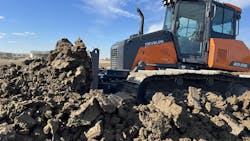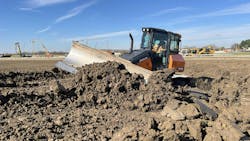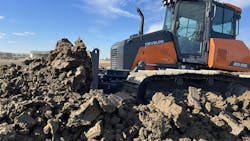Operators Test Develon DD130 Dozer
In case you haven’t been keeping score, South Korea-based excavator, wheel loader, ADT, and material handler manufacturer Doosan has rebranded as Develon, upping its North American game by introducing CTLs—and two crawler dozers.
It’s part of an expansion strategy overseen by a confusing cadre of corporate names, but the message is that the Develon line is here to stay and grow.
In 2022 the company introduced the DD100 crawler in the under 140-horsepower category. Its second dozer to market is the DD130, which checks in at 145 horsepower and has a six-way power-tilt angle blade, standard electro-hydraulic controls, and a heavier than usual frame for its size.
Visualize a D4-sized machine only with a whole lot of orange.
It isn’t often that a major category like dozers sees the arrival of a new OEM, so the DD130 was an easy choice for a Construction Equipment Field Test.
International Union of Operating Engineers Local 150 in Wilmington, Illinois, hosted the test on a sterling November day. Conditions were medium sloppy just 48 hours after a significant rain.
Operator/instructors and dozer experts Josh Zimmer and John Ambrose did the honors, which included fine grading, slot dozing, and operation on a slope. Troy Hitchcock, field product manager for Develon, was on hand to conduct a walk-around and familiarize them with the unit.
Hitchcock started with the six-way PAT blade, pointing out the curvature and reversible cutting edges.
“We also have a manual pitch, so we can change the blade from 48 [degrees] to 56 pitch,” Hitchcock said. “We can bring it back or throw it forward. If you roll it back, you get a little more of a carry whenever you’re doing fine grading; you roll it forward and you can do more cutting because it rolls the edges in to take more material.”
Visibility to the blade is something Develon said differentiates the dozer from its competitors. In addition to the cab’s low-profile front pillars for maximum glass area, all-glass doors provide a big view of the working environment. But even more noticeable is the hood’s diving slope.
“We have a nice slope on the front hood; we were able to do this because the radiator and the cooler are in the back,” Hitchcock said. “The only things up here are our charge air cooler, our fuel filters, and our ECM. You’ll also notice that on our hood, we don’t have an air cleaner sticking up.”
The air cleaner is under the hood, Hitchcock pointed out. There is a pre-cleaner around it that looks like an elongated oval. “That’s what this outside part is. The way it runs through there, it will drop the dirt out of it so that way it doesn’t make it to your full air cleaner. Pull that off, clean it, and stick it back on without having to mess with your air cleaner.”
Both operator/instructors lauded the visibility almost immediately after the grading task.
“The visibility is the biggest thing with dozers; A+ for visibility on that thing,” Zimmer said.
“That’s probably the best visibility I’ve seen in any machine,” Ambrose added. “I’ve always been a big fan of Komatsu in the past with the slanted nose design, and I think [Develon] has even brought it up a level further where it slants a little bit more and you have no obstructions to your field of vision.”
For further visibility, a standard rearview camera provides operators with an additional view of the dozer’s surroundings. The full-color, 8-inch touchscreen display shows the rearview camera view.
A low-angled November morning sun during the test looked like it would pose a challenge to the monitor display but that wasn’t the case.
“The screen was good,” Zimmer said. “Where it’s at, I wasn’t getting any glare off it. As far as using the touchscreen goes, I think it’s phenomenal. Two or three pushes of a button and you can change the sensitivity of the blade speed. It was set on normal for my passes, but I did change it to a faster pace. I liked that better, and it took a matter of seconds to switch it out.”
Also standard are four high-illumination LED lights, two in front and two in back, to enhance visibility when working in low-light conditions. Two additional LED lights are available as an option.
This DD130 had the optional 2D grading system that does not require GPS or lasers. The operator programs the needed inputs, and the machine controls blade functions.
“The 2D system seems like it’s pretty nice; however, I did feel like when I was trying to cut the flat pad, when I had initialized the 2D, it felt like it would drop the blade 2/10ths right out of the gate,” Ambrose said. “That made it feel like it wasn’t going to be able to hold the grade I was trying to match.
“I’m not sure if it was operator error, but as soon as I pushed the button to engage it, the blade would drop down a couple tenths,” Ambrose said.
“It seemed to try to follow the grade it wanted to after the dip, but if I’m trying to match into something, if I have an established grade and I had a grade checker giving me a zero mark, and that’s where I set myself up…if the blade dips down two tenths, it’s going to instantly start undercutting ever so slightly,” Ambrose said.
“[Develon] was saying that you have to sometimes compensate and lift back up, but if you’re already walking off a dip on something you’re trying to finish grade, it kind of defeats the purpose,” he said.
Optional 3D machine guidance and machine control features will be available in the future for use with the DD130 dozer, according to Develon.
Ambrose focused further on the controls.
“The other thing I wasn’t too fond of was on the autos controls,” Ambrose said. “To engage them, you have to press and hold the button for two or three seconds for it to engage, and I didn’t like that. When I go to hit that button if I’m catching grade, matching grade, I’d rather instantly activate it rather than have a delay.
“I was told the delay was put in there so you don’t accidentally engage it, but working with GPS for 20-some years, I don’t accidentally engage my autos when I don’t want to them to engage anymore,” Ambrose said.
“Then it seemed it was kind of hard to disengage them when I wanted to take it out of the 2D system, where I wasn’t sure if it was disengaged or not,” Ambrose said. “Sometimes I’d bring my blade back down and they were still engaged, and it would try to cut grade again maybe in a spot where I wasn’t prepared to cut grade.”
Zimmer was impressed with the blade and its features.
“It was very comfortable to run,” Zimmer said. “I’ve never been on one with the blade shake feature. That’s a very nice feature. I did most of [the grading] with Eco mode, and it still had plenty of power. I just switched into Power mode when I got in the heavier part of the pile and still had the power to do it.”
He foresees a particular fine grading role for the dozer. “I think it would be really good for fine grading, especially some nice clean stone that hasn’t been a pile that’s been compacted straight out of a truck,” Zimmer said. “I would say you could probably take a truckload of stone and in two or three passes have it graded out.”
The speed of the hydraulics was a minor issue for Ambrose. “I found even though it does have the fine, medium, and fast settings for the hydraulics, even when I knocked it down to medium it felt a little bit too touchy, too sensitive,” he said. “The electronics over hydraulics, I feel like those can all be dialed down—their medium should be their fast and the fine should be their medium—they could knock it down a little.
“I guess that would all depend on operator capability, but personally I don’t see anyone being that quick with their touch and feel to be able to match that speed setting,” Ambrose said. “I feel like it’s above and beyond what would ever be necessary on a dozer.”
Still, the veteran operator/instructor gave the unit’s performance high marks.
“I was surprised how manueverable it was,” Ambrose said. “I like the machine for the most part, just like any new machine it’s going to take… I bet by the time the shift was over I’d be completely use to the way the machine feels. It takes a little time to get used to anything. I did like it.”
After grading, it was time for slot dozing, where the operator/instructors could let loose and hog maximum amounts of dirt.
“This is a little bit moist, chunkier clay and material, so a little more dense,” Zimmer said. “The machine had no problem pushing a blade full while simulating slot dozing, cutting the middle out and then going down the slot. More than a blade full was no problem whatsoever. I was happy with the performance on it.
“The blade maneuverability is good; you can go into the settings on that and adjust how quick you want it to move and it seemed real smooth,” Zimmer said. “I loved the way the dirt rolled off the top of the blade. It rolled very well. Kept it off to the side so you didn’t get too much overload.”
Zimmer had one suggestion on the machine’s blade angle.
The latest from Develon
- Develon advances compact strategy with mini-wheeled excavator
- Develon intros DTL35 CTL, its first in North America
- Develon's DX17Z-7 excavator
- Develon HB-series hydraulic breaker attachments
- Develon redesigns DX62R-7, DX63-7 mini excavators
“On the angle on the blade, it’s a thumb roll control and it goes vertically--I think that would be a little bit easier if it was horizontal. You know which way you’re going. You could lose focus on something else and with that switch being vertical, you might go the wrong way right off the bat,” Zimmer said.
“Where I think if it was horizontal, whichever way you roll your thumb is the way the blade’s going to angle.”
Ambrose commented on the power.
“It’s got plenty of power, granted we were dealing with some gummy clay today, but it’s capable of pushing a giant pile in front of the blade,” Ambrose said. “The only thing I noticed was the steering. I’d go to steer in this tackier clay I was in, and it almost felt like it was laboring to make its turns. Like it wanted to almost stop its direction before it started moving again. That’s like robbing Peter to pay Paul, stopping to help steering.
“And that was without a big load in front, which I haven’t seen so much in other hydrostat dozers,” Ambrose said. “In those you can steer and move, and it doesn’t really bog you down.”
Toward the end of his slot dozing, Ambrose was working on a round-shaped berm.
“I wanted to make a couple of different slopes off that where you traverse off of a one-percent slope to the complete opposite just to get a feel for how smooth I could transition my blade and roll from one angle to the complete opposite coming out of a ditch then onto a berm,” Ambrose said.
“As far as that goes, she was really nice,” he said. “I could see myself being able to do some nice finish work, like at golf courses where you’ve got all kinds of contours and shapes and berms going on.”
The final test was steeper slope work, with sloppier wet dirt six or eight inches deep on the top, but drier material on the sides.
For stability and comfort, the DD130 comes standard with an oscillating serrated track system. Develon said the oscillating serrated track system follows the terrain and enables more precise blade control.
“The rollers on the bottom have different flanges on them,” Hitchcock said. “We have some with outside flanges and some with inside flanges. That way it keeps the track running straight and keeps it from flying around so much—it gives you a longer life on your track.
“This machine has a common guard with a single track guide on it,” Hitchcock said. “We do have a full track guide, so that way you can work in heavy rock or anything like that, it would keep all that out.”
Indeed, material was rising high on the tracks during the slope testing.
“It was about a 3:1 slope on that stockpile when we started it,” Ambrose said. “I wanted to get it to the point where it was a 2:1 slope. Most dozers will typically start to slide if it gets to be too much beyond that under a load.
“The machine itself felt very stable,” Ambrose said. “I did get myself to the point to where it was a 2:1 slope on there, and as far as stability on the slope, it felt excellent. The low center of gravity kept it right where it needed to be.”
Zimmer also liked the stability. “The stability was good, [the material] was a little bit greasy in spots and it still didn’t want to slide, so that’s a good thing.”
Both operator/instructors questioned steering power on the slope.
“I did notice it was lacking a little power on the slope when you went to turn with a blade full of material,” Zimmer said. “It stuck to the slope even being damp, if you stayed there without turning, it did pretty well. Once you tried to turn it, it hesitated a little bit.”
Ambrose zeroed in further on the turns.
“If I tried to turn up the slope, it was so restrictive on the hydraulics it basically stopped the machine in its place,” he said. “I couldn’t steer whatsoever, even with minimal material in front of the blade. I had to back up each time and had to abort the push and steer away from it. Even without material in front of the blade, it had a hard time turning up the slope versus running along with the slope.”
Although there is no setting to adjust the steering power, Ambrose adjusted the traction control. He had started the exercise running in full power without traction control on.
“We had gone through a number of settings,” he said. “I changed some settings on the traction control and that was to no avail.”
Overall, Ambrose was pleased with the dozer. “It seems like it would be a great machine to work on slopes because it has a very low center of gravity, and the visibility is nice. If they could just get it to steer a little bit better, I think it would be excellent on slopes, especially steep slopes.”
Zimmer agreed: “Definitely tons of power for its size and very comfortable to run. Everything is nice on the right-hand controls. You could do a 12-hour day in it, be comfortable and not be sore at the end of the day.”
Sounds like solid praise for a newcomer in a mature category.
About the Author
Frank Raczon
Raczon’s writing career spans nearly 25 years, including magazine publishing and public relations work with some of the industry’s major equipment manufacturers. He has won numerous awards in his career, including nods from the Construction Writers Association, the Association of Equipment Manufacturers, and BtoB magazine. He is responsible for the magazine's Buying Files.




